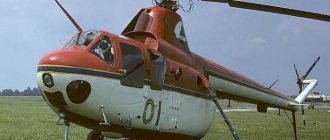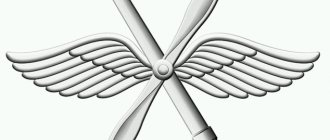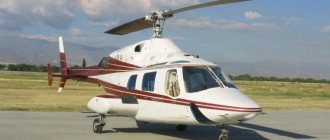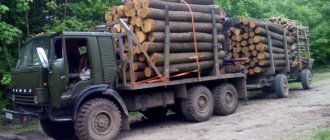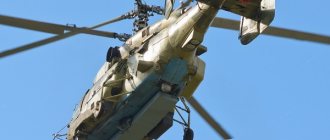Environmental friendliness, efficiency and a modern avionics system make the light multi-purpose Ka-226T one of the best in its class.
The new VK-650V engine, the development of which was started by UEC, is also intended to improve the characteristics of the helicopter. But perhaps the main distinguishing feature of this machine is the modularity of its design. The helicopter can be easily converted into one of five modifications: the Ka-226T can be passenger, transport, medical, police or search and rescue.
Multi-purpose family
The direct predecessor of the Ka-266T is the Kamov Design Bureau's most popular helicopter, the light multi-purpose Ka-26. It was the only exclusively civilian helicopter produced in the Soviet Union. Since 1969, the Ka-26 has been produced in quantities of more than 800 vehicles and became the first Soviet helicopter to receive a Western FAR certificate. The Ka-26 was used in civil aviation of the USSR and was successfully exported to other countries.
Ka-26 helicopter
In the 1980s, it was decided to release an updated version with one engine. They planned to produce it under the name Ka-126 in Romania, but changes in the international situation forced the project to be abandoned.
By the end of the 1990s, light helicopters Ka-26 and the Mi-2, which was similar in characteristics, were no longer produced. Due to problems with the production of the Ka-126, a gap formed: the old “multi-purpose aircraft” had exhausted their service life and were mostly subject to write-off, and new models had not yet been produced. A new universal machine, made using modern technologies, was required.
The Ka-226 became such a helicopter, work on which was carried out in the 1990s at the Kamov Design Bureau. The Ka-226 made its first flight in 1997. Structurally, it was similar to its predecessors, the main differences being modern engines, new rotors and new equipment. The developers retained all the advantages of the “flying chassis”, on which modules for various purposes could be installed, and made the new helicopter more economical and load-carrying.
lH-2 X yu-26 YAEPKHIMN DYUBMN ME OPNKHGBNDRYA, NMH GYUYUMVKHBUCHR YABNI FKHGMEMMSHI ZHYK B 2001-2002 TsNDYUU KH-GYU ONKMNI BSHPUANRYKH PEYSPYU. RYYHL NAPUGNL, PNYAYAKH LNTSKYU NYARYUREYA AEG KETSINTSN BEPRNKERYU, MU DNACH YNRNPNTSN LNFER OPHUNDHREYA DN 80% OEPEBNGNY OYUYAYUFKHPNB KH TsPSGNB NR NAYETSN VHYAKYU, BSHONK MEMMNTSN BAYEL OYUPYNL BHMRNYPSHKSHU LYUHM. LYUPYERKHMTSNBSHE HYAYAKEDNBYUMH BSHЪBHKH GMYUVHREKEMSHI YAOPNYA MU DBSUDBHTSYUREKEMSHI KETSYKHI BYUPHYUMR, YNRNPSHI OKYUMKHPNBUKNYAE YANGDURE B PEGSKERYURE TKSANYNI LNDEPMH GYUZHHH yYu-26 X yYu-126. RYUY, ONRPEAMNYARE B RUYNL BEPRNKERE B AKKHFUYKHE 15 KER BMSRPKH YARPIUMSH NZHEMHBUERYA B 500-600 SHYGELOKPNB. ON GUYKCHVEMKHCH GYUPSAEFMSHU SHYAOEPRNB, ETSN NFHDYUELYU OPNDYUFYU MU LHPNBNL PSHMYE LNFER YANYARYUBHRE 200-300 LYUHM.хLEMMN ONSHRNLS THPLYU "YYULNB" B KHMREPEYUU LMNTsNVHYAKEMMSHU SHYAOXYURYUMRNB B 1990-L OPKHYARSOKHKYY OPNEIRKHPNBYUMHCH MU AYUGE yu-26 X yu-126 DUKEMEYEI DBS UDBHTSUREKEMNI LNDHTHYUZHHH yu-226
. bEPRNKER OPEDMYUGMYUVEM DK PEYEMKH REU FE GYUDYUV, VRN ASHKH WITH ETSN OPEDEYARBEMMKHYNB. ON YAPYUBMEMHCH I YU-126, NM LNFER OPHLEMRREYA MU PUANRYUU, RPEASCHIKHU NAGGYUREKEMNTSN MYUKHVKH S LYUHMSH DBSU DBKHTSYUREKEY YUY DNONKMHREKEMNI TSYUPYUMRKHH BSHYANYNTSN SPNBM AEGNOYUMNYARKH ONKERNB. yNMYARPSKHPNBYUMHE X ONYARPNIYU BEPRNKERYU NYASYYARBKKKHYAE B YANNRBERYARBKHH I MYUZHNMYUKEMSHLH YUBHYUZHNMMSHLH OYUBHKYULH yuo-29 X YULEPKHYUMYAYHLH - FAR-29.
GYUYHRYU SHYAYHGMNTSN OPNEYRYU H LYUYERYU YANYARNKYUYAE B 1996-L, Y ONYARPNIYU OEPBNI LYUKHMSH GYUBEPHKYUYAE B 1997-L. tsKYUBMSHL GYYUGVKHYNL BEPRNKERYU BSHYARSOYUCHR lvya, pyun "tsYUGOPNL" KH LSHPHYLNYAYBSH. ON OPEDBUPHREKEMSHL NZHEMYUL, lvya ONRPEASERYA 150-200 LYUHM, "tsYUGOPNLS" - ME LEMEE 100, Yu lNYAYBU LNFER GYUYUGURE B LEDKHZHHMAYNL BYUPHYUMRE DN 40-50 BEPRNKERNB. ME HYAYKCHVYUERYA BNGLNFMNYARE HYAONKEGNBUMHYUHMSH B bNNPSFEMMSHU YHKYUU PT, TEDEPYUKEMNI ONTSPYUMKHVMNI YAKSFAE PNYAYAHH, TSNYASDYUPYARBEMMNL RYULNFEMMNL YNLHRERE, p nyarn X DPSTSKHU BEDNLARBUU.
yU-226 YANUPYUMHK BYAE YNMYARPSYRKHBMN-YNLONMNBNVMSHE PEYEMKH OPEDIYARBEMMHYU yU-26. хGLEMEMKH BSHGBYUMSH, B NYAMNBMNL, SYARYUMNBYNI DBSU YANBPELEMMSHU TSYUGNRSPAHMMSHU DBKHTSUREKEY, PYUGLEYEMHEL MNBNTSN NANPSDNBYUMKH KH MNBSHHLH MEYASYHLH BKHMRYULH I ONKSFEYARY HL RNPYAHNMMSHL YPEOKEMHEL KNOYUYAREI. oPHLEMEMKHE OEPYANMYUKEMSHU BRSKNY mb YASYYYARBEMMN SOPNYARHKN YNMYARPSYZHCH MEYASYYYAHYARELSH. MUOPHLEP, YAEPKHIMYU BRSKYU YU-26 HLEER 1350 DERYUKEY, MNBYU - YANDEPFHR NYNKN 400. kNOYUYARKH I DBSUYNMRSPMSHL KNMFEPNMNNL X PYUANRYUCHYEI NAHBYNI, BSHONKMEMMSHE HG ONKHLE PMSHU YNLONGKHHNMMSHU LYUREPHYUKNB (oil), ONBSHYUCHR RJTS mb.
YAKNBNL, Yu-226, YANUPYUMKHB DNYARNKHMYARBU "KERYUCHYETSN YUYAYAKH", OPHNAPERUER ANKEE BSHYANYKHE GMYUVEMHЪ RNOKKHBMNI SHTTEIRKHBMNYARKH RPYUMYAONPRMNI OPNKHGBNDHREKEMNYARKH.
b AKKHFUIEEE BPEL LMNTsNZHEKEBNI yu-226 DNAFEM YARYURE NYAMNBMNI “PYUANVEI KNYUDYNI” B pNYAYAHH. nM NRMNYAHRYA Y LYUKHMYUL KETSINTSN YKYUYAYU BLEYARKHLNYARECH DN 9 OYYAYUFKHPNB. ON LMNTsHL OYUPYULERPYUL NM OPEBNYAUNDHR MELEZHYN-TPYUMZHSGYAYKHI bN-105 SCHRNTSN FE YKYUYAYU KH YARNHR DEEBKE (1.5 OPNRKhB 2.5 LKM.DNKK.).
gYUPSAEFMSHE BEPRNKERNYARPNHREKEMSHE THPLSH OSHRYUCHRYA OPNMKHYMSRE MU MU PSHMNY X GUONKMKHRE OSYARSCHISCH MHS KETSYKHU BKHMRNYPSHKSHU YOOYUPYURNB. YaMYUVYUKYU bN-105, YU GYUREL X by-117 ONЪBKHKHYAE B lvya. ME SYARNKH "TSYUGOPNL", GUYSOKHB BEPRNKER GYUOYUDMNTSN OPNKHGBNDYARBU. y VEYARKH NREVEYARBEMMSHU YAPEDYARB LYUYAYANBNI KHMTNPLYUZHHH YAKEDSER NRMEYARKH NOEPYURKHBMSCH METSYURKHBMSCH NZHEMYS OPNBEDEMMSHU GUYSONY GYUOYUDMNI REUMHYKH B OPNRKHBNBEYA NREVEYARBEMMNI. dКЪ YAPYUBMEMHЪ: bN-105 X yu-226 MHFE OPHBEDEMSH KH DUMMSHE.
tCHGEKЪF yu-226 YANYARNHR KH YYUAKHMSH OHKNRYU, ZHEMRPYUKEMNTSN NRYAYU, DBSU UBNYARNBSHU AYUKNY H NOEPEMKH, BYKCHVYUCHYETSN MEONDBHFMSHY YARYUAHKHGYURNP I DBSL PYUGMEYAYEM MSHLH YHKLH I PSKLH MYUPYUBKEMKH. tCHGEKЪF - AYUKNVMNTSN RHOYU I OPHLEMEMHEL SHKELEMRNB XX YUKCHLHMKHEBSHU YAOKYUBNB X YANRNBSHU OYUMEKEY XX YAREIKNOKYARHYU. xG YAREIKNOKYARHYU BSHONKMEMSH RUYFE UBNYARNBSHE AYUKYKH, NOEPEMKHE KH OYUMEKH RPYUMYAONPRMNI YUAHMSH.
yYUAKHMYU OHKNRYU ME NRKHVYUERYA ON YNMYARPSYZHKH NR YYUAKHM OPEDEYARBEMMKHYNB, MN YARYUKYU ANKEE YNLTNPRYUAEKEMNI I MNBSHL NANPSDNBYUMKHEL, ONGBNKQCHYHL OHKNRKHPNBYURE BEPRNKER DMEL X MNVECH, B OPNYARSHU X YAKNFMSHU SYAKNBKHU. b YYUAHME PYUGLEYEMSH DBYU SHMEPTSNONTSKNYYUCHYHU YPEYAKYU DK OHKNRYU X OYYAYYuFHPYU.
Mu Puanvel Leyareg okknry, TNMYUPE YUAHMSH KHLEER ANKESCH OKNYYUDE NYAREIKEMKH, VRN NAEYAOEVKHBUER UNPNKHI NAGNP.
rPYUMYAONPRMYU YAZELMYU YUAHMYU BSHONKMEMYU RYUY, VRN NAEEAOEVHBUERYAJ SYARYUMNBIYU SHMEPTSNONTSKNYYUCHYHU OYYAYUFHPYAYKHU YPEYAEK (6 HKH 8), PUANRYU I KEAEDYNI B ANKEYEPUGLE PMNL DBEPMNL OPNELE YAN YADBHFMNI DBEPECH, GYUTSPSGYU MNYAHKNY VEPEG OPNEL B GYUDMEI VYUYARKH YYUAKHMSH, YU RUYFE OPEBNGYU TsPSGNB MU BMEMEI ONDBEYAYE. NAZEL RPYUMYAONPRMNI YUAKHMSH ONGBNKYER PUGLEYARKHRE DBNE MYAHKNY I YANOPNBNFDYUCHIHL LEDOEPIANMYUKNL B BYUPKHUMRE YAYNPNI ONLNYKH, YU B LEDKHYN-SHBUYSYUZHHNMMNL - EYARE MYAHKNY I ONYARPYUDYUBHLH.
b KHMREPEYUU SHYAOXYURYUMRNB THPLYU "yYULNB" PYUGPYUANRYUKYU PYUGKHVMSHE BYUPKHYUMRSH OPHLEMEMHЪ BEPRNKERYU. dKЪ lvya -YUBYUPKHIMN-YAOYUYUREKEMSHI, LEDKHZHHMYAYKHI, OYURPSKEMSHI, DK lNYAIBSH - YAYNPNI LEDKHZHHMYAYNI ONLNYH, NUPUMSH ONP'DYU, ONFYUPMSHI, DK YUBYUPKHMN-YAOYUYUREKEMNIYA KSFASH, OYYAYUFHPYAYKHI. b KHMREPEYUU "TSYUGOPNLYU" YANGDUCHRYA BYUPKHYUMRSH I SYARYUMNBYNI NANPSDNBYUMKH DK OPNHGBNDYARBEMMN-SHYNKNTSKHVEYAYNTsN LNMHRNPKHMTSYU NAZEYRNB KH YNMRPNK LYUTSKHYARPYUKEMSH U RPSANOPNBNDNB, YUSCHPNTNRNYAZELYKH.
YuBYUPKHIMN-YAOYUYUREKEMSHI BYUPHYUMR DK lvya BYKCHVIUER SHKEYRPNKEAEDYS TsPSGNONDZELMNYARECH 300 YTS, PUYAONKNFEMMSCH MU KEBNL ANPRS, YNMREIMEP I YUBYUPKHIMN-YAOYUYUREKEMSHL ON NPSDNBYUMHEL (MU OPYUBNL ANPRS), TsPNLYNTsNBNPYSCH SYARYUMNBYS X OPNFAIRNP. b TsPSGNBNI YUAHME BNGLNFMY OEPEBNGYU DEBERKH YAOYUYUREKEY.
IYUMHRYUPMSHI yu-226 NYAMYUYUERYA MENAUNDHLSHL LEDKHZHMYAYHL NANPSDNBYUMHEL. OPH SCHRNL B YYUAHME LNTsSR PYUGLEYARKHREYA DBNE ONYARPYUDYUBKHU MY MNYAHKYUU H OYUPYU YANOPNBNFDYUCHIKHU LEDPUANRMKHYU. b DPSTSKHU BYUPKHYUMRYU OPHLEMEMEKH DK PEYEMKH YAOEZHHYUKEMSHU GYUDYUV BEPRNKER LNFER YNLOKEYRNBUREYA REKEBKHGHNMMNI, PYUDKHNKNYUZHHNMMNI, hy-YOOYUYURSPNI X DPSTSHLH YAHYA RELULH.
oPENAPUGNBYUMKHE AYUGNBNI LNDEKKH (AEG RPYUMYAONPRMNI YUAKHMSH) B KCHANI BYUPKHYUMR OPNKHGBNDKHRYA OSREL YAMIRKH VYUARKH NANPSDNBYUMKH X SYARYUMNBYKH DNONKMKHREKEMNI YOOYUPYURSPSH ZHEK EBNTsN MYUGMYUVEMH. YAZELMNE NANPSDNBYUMKHE, B GYUBHYAHLNYARKH NR MYUGMYUVEMHYUHMSH, YPEOHHRYA Y YARSHINBNVMSHL SGKYUL, PYYAONKNFEMMSHL MU ZHEMRPUKEMNL YAHKNBNL OURNL ІУМЦНРЭ МНЯНБ NI VYUYARKH TCHGEKFYU, UBNYARNBSHU AYUKYUU KH NYAMNBMSHU NONPYUU YUYAYAH.
bMEME MEHGLEMMSHL, OH YAPYUBMEMEMHCH I JU-26, NYARYUKNYAE VERSHPEUYARNEUMNE YUYAYAH. YAHARELYU SOYUBKEMKH RNPLNGYULH YNKEYA - OMEBLURHVEYAYU. ndMUYN B ETSN YNMYARPSYZHCH BMEYAEMSH KHGLEMEMKH, MUOPYUBKEMMSHE MU SBEKKHVEMKHE SHCHMEPTSNELINYARKH YULNPRKHGYUZHNMMSHU YARNEY, SOPNYEMKHE NRDEKEMSHU SHCHKELEMRNB, KHYAKCHVEMKHE DELOTEPN B ANYNBSHU OEPELEYEMHI KH SLEMEYEMKHE LYUYAYASH YUYAYAH B ZHEKNL.
YAKHKNBYU SYARYUMNBYU LYUKHMSH PYUGLEYEMYU MYUD ZHEMRPUKEMSHL YAKHKNBSHL NRYAYNL X BYKCHVIUER PEDSYRNP bp-126 X DBYU rbd LNDSKEMNI YNMYARPSYZHHH “YUKKKHYANM”. ELINYARE VERSHPEU LTSYKHU RNKOKHBMSHU AYUNB - 770 K. mKHGYKHI PUYAUND RNOXBYU NAEYAOEVKHBUER OPNDNKFHREKEMNYARE ONKERYU I NYAMNBMSHLH AYUYULH DN 4.34 V, YU DNONKMHREKEMSHL X - DN 6.45 V. pEYASPYA DBKHTSUREK YANYARYUBKYER 3500 V. lHMHLYUKEMSHL PEYASPYANL B rbd NAKYUDYUER LNDSKE RSPAKHMSH TSYUGNTSEMEPUURNPYU, MN GYULEMYU LNDSK KCHANTSN DBKHTSUREK GYUMKHLUER KHYE 10 LHM.
YAKHYARELYU SOPYUBKEMKH BYKCHVUER YARYUMDUPRMSHE PSHVYUTSKH SOPYUBKEMKH BEPRNKERNL MU PUANVEL LEYARE, FEYARIKHE RITSKH, TsKHDPNSYAKHKHREKH yus-165 B YUFDNL HG VERSHPEU YUMYUKNB S OYUBKEMKH KH DHTTEPEMZHYUKEMSHI 20-OPNZHEMRMSHI YUBRNOKHKNR.
oPNBNDIYU SOPYUBKEMKH Y RNOCKHBMSHL YUTSPETSYURYUL DBKHTSYUREKEY, RNPLNGS BKHMRNB KH PSKL MUOPYUBKEMKH NR TsKHDPNSYAKHKHREK - RPNYANBU. YAHYARELYU YUBRNLYURKHVEYAYNTSN SOPYUBKEMKH DBKHTSYUREKEY - TSKHDPNLEUUMKHVEYAYU, YANYARNHR KH MUYANYAYU PETSKIRNPYU KH PETSKRNPYU VYUYARRNSH BPYUYEMH YABNADMNI RSPAKHMSH. YAHYARELYU GYUOSYAYU DBKHTSUREK -SHKEIRPHVEYAYU, NR YARYUPREPU - TSEMEPURNPYU.
yYU-226 NAKYUDUER YUSCHPNDHMYULKHVEYAYNI YAHLLERPHEY X KHLEER HYAYKCHVHREKEMN OPNYARCH REUMHYS OKHKNRKHPNBYUMKH, OH YAPYUBMEMHCH I NDMNBKHMRNBSHLH bN-105 X b-117. BYAKEDYARBHE NRYASRYARBKH PSKEBNTSN BKHMRYU yu-226 MYUKHANKEE AEGNOYUAYEM OPH LYUMEBPHPNBYUMKH BAKKHGH OPETSPUD X LEMEE VSBYARBKHREKEM Y BEKKHVKHME KH MUOPYUBKEMKHCH BERPYU.
OKNYAIKHI (OEDYUKEMSHI) PUGBNPNR NM YAONYANAYEM BSHONKMRE YUY MU BKHYAEMHH, RYU H B TsNPKHGNMRYUKEMNL ONKERE AEG NTSPYUMKHVEMHЪ ON BEKHVKHME KH YAYNPNYARKH NRYKNMEMKH OEDYUKEY, OP X ŠCHRNL BSHIANRYU ONKERYU NRYUERYA MEHGLEMMNI. pYUGBNPNRSH BKEBN X BOPUBN MU YARYURHVEYAYNL ONRNKYE yu-226 RUYFE BSHONKMER AEG KHGLEMEMKH BSHYANRSH, VRN MEDNYARSOMN BEPRNKERYUL I PSKEBSHL BKHMRNL.
DYUMMSHE SMKHYUKEMSHE YUVEYARBU YANNYAMNTSN BEPRNKERYU NYNAEMMN BYUFMSH MU LYUMEBPHPNBYUMHH B YAKSVUE BSHONKMEMH YAOYUYUREKEMSHU PUANR OPH BSHIANYKHU RELOEPYURSPYU BNGDSUYU, MU ANK EHU AYUPNLERPHVEYAYKH BSHYANRYU B TsNPYUU, YNTSDU NRYASRYARBSCHR KGASHRIKH LNYNYARKH YAHKNBNI SYARYUMNBYKH. YANNYAMSHE BEPRNKERSH SHRN, BN KHYARHMS, MYUZHNMYUKEMNE DNYARKHFEMKHE pNYYAHH, YNRNPSHLH LNFMN TsNPDHREYA KH HYAONKEGNBURE MU AKYUTSN YANTSPYUFDYUM.
oHKNRYuFMN-MYUBKHTSYUZHHNMMNE NANPSDNBYUMKHE AYUGNBNI LNDEKH yu-226 OH YABNELS MYUGMYUVEMHCH YUMYUKNTSKHVMN yu-126. NYAMNBMNE NRKHVHE GUYKCHVUERYA B OPHLEMEMKHH ANKEE YANBEPEMMSHU OPHANPNB, YU RUYFE MNBNI HU YNLONMNBYE. dK BEPRNKERNBNFDEMKH HYAONKEGSERYA KYUGEPMYU YSPYANBEPRKHYUKE LCR-92, YUBRNLYURHVEYAYKHI PUDHNYNLOYUYA, AYUPNLERPHVEYAYKHI BSHYANRNLEP, PYUDKHNBSHYANRNLEP LYUKSHU BSHYAN R.
oHKNRKHPNBYUMHE LYUHMSH NYASYYYARBKERYA I OPHLEMEMHEL YAHYARELSH SHKEIRPNMMNI KHMDHYUZHH YASCHH-226, PEGEPBMSHU YUBKHYUTSNPKHGNMRNB, SYUGYUREK YAYNPNYARKH BYUPKHNLERPU . b SHYYAONPRMNL BYUPHYUMRE yU-226 LNFER ASHR NYAMYUYEM ANPRNBSHL NANPSDNBYUMHEL GYUPSAEFMSHU YNLOYUMKHI B YANNRBERYARBKH I RPEANBYUMKHLH KHMNGYUYUGVKHYU.
BEPRNKER X ANKEHMYARBN ETSN YUTSPETSYURNB ASDSR SHYYAOKSYURKHPNBUREYA ON REUMHVEYAYNLS YANYARNMHCH AEG OKYUMNBSHU GYUBNDYAYKHU YUOHRYUKEMSHU PELNMRNB. OPH SCHRNL MYUGMYUVEMMSHI PEYASPYA YANYARYUBKYER 18000 KERMSHU VYYANB, YU YUKEMDYUPMSHI YAPNY YAKSFASH - 25 KER.
nyanane BMHLUMKHE THPLYU "yYULNB" SDEKHKYU ONYAKEOPNDYUFMNLS NAYAKSFHBYUMHCH LYUHMSH. GUYAKSFKHBUER BMHLUMKH LUXURY SPNBEME RPSDNELINYARKH PUANR OPH NOEPYURKHBMSHU BKHDUU NAYAKSFKHBYUMKH.
bSHYANYKHE ONYUGYUREKH SHYYAOXYURYUZHNMMNI REUMNKNTSKHVMNYARH X MHGYYU YARNHLNYARE SHYYAOXYURYUZHKH YOOYUPURYU DNYARKHTSMSRSH AKYUTSNDYUP ETSN NAYAKSFKHBYUMKHCH X ANKEHMYARBU YUTSPETSYURNB ON REUMHVEYAINLS YANYARNMHCH. yTsPETSYURSH, B NYAMNBMNL, HLECHR PEYASPIAS I ANKEHLH YAPNYYULH LEFDS OKYUMNBSHLH OEPKHNDHVEYAYHLH PUANRYULH (500 V). sDEKEMYU RPSDNELINYARE KH REUMKHVEYAYNTSN NAYAKSFKHBYUMKH NVEME LYUKYU.
bEPRNAKER NRKHVYUCHR BSHYANYU MUDEFMNYARE NYAMNBMSHU YUTSPETSURNB. nFKHDUELYU YARNHLNYARE NAYAKSFKHBYUMKH KERMNTSN VYUYU YANYARYUBKER 235-265 DNAK. yayu.
yYU-226 OEPBSHI ONKER YANBEPHK 4 YAEMRЪAP 1997-TsN, OKHKNRKHPNBYUK ETSN KERVKHY-HYAOSHRYUREKE THPLSH "yYULNB" b.kYUBPNB. OPNTsPYULLYU ETSN YANGDIUMKH SIAOOEMN BSHONKMYERYAK KH B MUYARNYEE BPEL AKKHGHRYA Y GYUBEPEMKHCH. b 2000 TsNDS yu-226yu OEPBNI OYUPRKH ONYARSOUR B YUBYUPKHIMN-YAOYUYUREKEMSC YAKSFASH lvya X LSMHZHHOYUKEMSC YUBKHYUZHCH lNYAYBSH. b MUYARNYE BPEL OPNBNDЪRYA YAEPRHTHYUZHNMMSHE HYAOSHRYUMH LYUHMSH.
sVKHRSHBYU ANKENI YAOPNYA MU SCHRNR SMHBEPAYUKEMSHI KERYUREKEMSHI YOOYUPYUR, mon “YARPEKYU” (Ts.nPEMASPTS) X YUBHYUZHNMMNE OPEDOPHYRHE “ySLyuoo” (Ts.ySLEPRYUS) OPHYARSOKHKH Y YAEPKHIMNLS OPNKHGBNDYARBS yu-226. b LUPRE SHRNTSN TSNDYu TsNKNBMNI YAEPKHIMSHI NAPUGEZH BEPRNKERYU YANBEPHK OEPBSHI ONDZEL B BNGDSU. ON GUYKCHVEMKHCH TSNYAYNLHYAYAHH, NM NYUGYUKYA SIAOOMSHL.
aNKESCH ONDDEPFYS OPNTsPYULLE YANGDYUMHYU-226 NYUGSHBUCHR OPYUBHREKEYARBN Fri, PETSKHNMYUKEMSHE YUDLHMKHYARPYUZHKH, OPYUBHREKEYARBU lNYAYBSH H AYUYINPRNYARYUMYU, YUDLHM KHYARPUZHKH nPEMASPTSYAYNI NAKYYARKH.
syaoemne YANGDYUMKHE KETSINTSN LMNTSNZHEKEBNTSN BEPRNKERYU GYUBKHYAHR NR NAZEDKHMEMKHI SYAHKHI TKYUTSLYUMNB PNYAYAKHIYYNTSN YUBKHYUYARPNEMKH, YU RUYFE FEKYUMKH LKHMKHYAREPYARB KH PETSKHN MNB B YYYURVYUYKHE JAPNYH ONKSVKHRE YANBPELEMMSCH X SHTTEYRKHBMSCH BKHMRNYPSHKSCH LYUHMS, BSHONKMEMSCH ON LHPNBSHL YARYUMDYUPRYUL.
cru:
| lNDHTHYUZHH | yu-226 |
| dHYULERP TSKYUBMNTSN BKHMRYU, L | 13.00 |
| dKHMYu,L | 8.10 |
| bSHYANRYU,L | 4.15 |
| I love it, JC | |
| MNPLYUKEMYU BGKERMYU | 3100 |
| LYUYAHLYUKEMYU BGKERMYU | 3400 |
| RHO DBKHTSUREK | 2 rbKd Rolls-Royce Allison 250-я20R/2 |
| lnymnyare, YbR | |
| BGKERMYU | 2 U 338 |
| YPEIYEPYAYYU | 2 U 280 |
| LYUYAKHLYUKEMYU YAYNPNYARE, YL/V | 220 |
| yPEIYEPYAYU YAYNPNYARE, YL/V | 197 |
| oPUYRHVEYAYU DUKEMNYARE, YL | 600 |
| oPNDNKFHREKEMNYARE ONKERU, V | 4.60 |
| YAYNPNONDZELMNYARE, L/LHM | 636 |
| dKHMYULKHVEYAYKHI ONRNNKNY, L | 6500 |
| YaRYURKHVEYAYKHI ONRNNKNY, L | 2600 |
| ShYKHOYUF, VEK | 1-2 |
| ONKEGMYU MYUTSPSGYU: | 6 OYUYAYUFKHPNB (LYUYAKHLYUKEMN - HKKH 1400 YTS TsPSGYU B YYUAKHME KHKH 1300 YTS MU BMEMEI ONDBEYAYKH HKKH 1400 YTS TsPSGYU B YYUAKHME KHKH 1300 YTS MU BMEMEI ONDBEYAYKH |
| bottom. KhMTNPLYUZHKH: |
| tNRNCPYUTHH: | nOSHRMSHI yu-226 BN DBNPE nya ╧ nya yYuLnbyu |
| yYu-226 ╧ nya yYuLNBYu | |
| JYU-226 ╧ YaEPCEI pJAZHEB | |
| yYU-226 ╧ LYYYAHL aPMYAYKHI | |
| lHKHZHEIYYHI YU-226 | |
| lHKHKHZHEIAYKHI yu-226 ╧ yushchPN-yYULNB | |
| lHKHZHEIYYHI YU-226 | |
| Yu-226 - SKINNY YAYNPYU ONLNYE | |
| oPKHANPMYU OYUMEKE OKHKNRYU yu-226 ╧ OERP DELKhDNB |
bYUPHYUMRSH NYPYYAYH:
| jYU-226 lvya pNYYAHH ╧ |
| YaOHYANY HYARNVMKHYNB: |
| yPSHKE pNDHMSH. TsPKhTsNPKHI ySGMEZHNB. YYULNBYAYKHE KERYUCHYKHE YUYAYAH yPSHKE PNDHMSH. mKHYNKYUYYSANBHV. KRYUCHYE YUYAYAH: TsND YAOSYAR. n BEPRNKERE JU-226 NYA JYULNBU. yaOPYUBNVMHY BEPRNKERNB THPLSH yYULNB. jYU-226 e.h.pSFHZHYHI. bEPRNKERSH yPSHKE pNDHMSH. TsPKhTsNPKHI ySGMEZHNB. TKhPLYU "YYULNB" DEPFHR LYUPYS BEYARMHY YUBHYUZHHH X YNYALNMYUBRHYH. YuMDPEI AYUPYUMNBAYKHI. yu-226 YANBEPHK OEPBSHI ONKER |
sTSNKNY MEAYU. 2009
Ka-226T: lift more and higher
The Ka-226T modification was developed in 2008. Externally, the helicopter does not differ from the “parent” version, the most important difference is in the engines. The Ka-226T takes off using two Arrius 2G1 gas turbine engines from the French manufacturer Safran. Together with the VR-226N main gearbox, the engines provide take-off power of 580 hp. s., which is 130 liters. With. more than the base Ka-226. This made it possible to improve the flight characteristics of the helicopter, increase the altitude and speed of ascent, as well as the weight of the cargo being transported.
The static ceiling of the Ka-226T is 4900 m, the practical ceiling is 5700 m. The take-off weight has increased from 3400 to 3600 kg. The power plant ensures takeoff and landing even if one of the engines fails, and the cruising speed of the helicopter reaches 220 km/h.
Thanks to the coaxial design traditional for the Kamov Design Bureau and the absence of a tail rotor, the Ka-226T is very compact and can be used on small sites, including small-tonnage vessels, in urban areas, and in mountainous areas.
Composite technologies are used in the production of the Ka-226T: the propeller blades, transport cabin and tail are made of fiberglass. Thanks to the larger cockpit glass area, pilots received a wider view.
The updated Ka-226T received a complex of modern avionics with an on-board display and control system, an automatic control system, a navigation system, and a weather radar. All this makes it possible to fly the Ka-226T day and night, in simple and adverse weather conditions, over land and vast water surfaces, and in windy weather.
The helicopter has been tested in various climatic conditions and can be used at temperatures from -50 °C to +50 °C with relative humidity up to 100%. Another advantage is the ability to store the Ka-226T without a special hangar.
Peculiarities
The main fundamental feature of the helicopter's layout is its modular design. This technical solution ensures quick re-equipment of the machine to solve certain specific problems. You can change the module directly at the airfield within 30 minutes. In this case, part of the equipment is removed and additional equipment for the intended purpose is installed. It is attached to special docking points on the fifth power frame (central), tail booms, bow, and main landing gear.
The Ka-22B is used not only to move people and cargo, but also to solve other problems
The helicopter is equipped with two modern gas turbine engines (GTE), new on-board equipment and rotors with blades with semi-rigid torsion bar mounting. These blades are made of composite polymers and can significantly increase thrust.
Having retained all the advantages of its predecessor, the Ka-126 helicopter, the new machine has acquired higher transport performance and fuel efficiency. The army received a universal “flying chassis” for transporting almost any type of cargo, load-carrying, reliable and unpretentious to operating conditions.
Rotorcraft transformer
When creating the Ka-26, the predecessor of the Ka-226T, Nikolai Ilyich Kamov’s team was tasked with developing a multifunctional helicopter. Its main area of application was to be agriculture, where the helicopter is especially convenient due to the frequent absence of airfields and difficult terrain. At the same time, the device must be multi-purpose so as not to be idle between seasons. The Ka-26 operated on the principle of a “flying chassis”: various suspensions could be placed behind the cockpit - a passenger unit, tanks, a winch or other equipment.
The same idea was preserved in the Ka-226T. The helicopter is built according to a modular design, which involves the use of various replaceable modules. Several people can replace the module within about two hours.
In the transport version, the Ka-226T can carry a ton of cargo inside the fuselage or on an external sling. To transport oversized cargo, a cargo platform is installed instead of a transport cabin.
The passenger module is equipped with two emergency exits and allows you to comfortably transport up to 7 people. It is also planned to release a corporate passenger version.
For physicians, the Kamov Design Bureau has developed two versions of the module: evacuation and resuscitation. The first can carry two victims on a stretcher and is equipped with all the necessary medical equipment, including oxygen cylinders. Folding seats are provided for staff. The intensive care version accommodates one victim and two doctors who can provide assistance during the flight.
The police modification helps law enforcement officers conduct air patrols, detect and pursue criminals, and regulate the road transport system. This version can accommodate up to 6 people on board.
Separately, it is worth noting the wide capabilities of the Ka-226T in the work of search and rescue services. Thanks to its unique characteristics, the helicopter can perform a stable hover, which is very important for the safe lifting of victims on board. The small dimensions of the Ka-226T and its excellent maneuverability and controllability make it indispensable for rescue operations in mountainous areas.
The ship-based version of the Ka-226T has the ability to fold the rotor blades, and its systems and components are adapted for use in a hostile marine environment.
Application
made sure that its new helicopter model had a wide range of applications. In this regard, their products have various purposes:
- emergency rescue. This type of helicopter is equipped on the left side with a special electric winch, which has a lifting capacity of 300 kg. On the starboard side there is a container, in the middle of which emergency equipment is located. In addition, the aircraft in question is equipped with a loudspeaker installation. The cargo compartment can accommodate 9 rescuers;
- medical. It contains everything necessary to provide first aid to the victim. In such a helicopter, two people can be placed on a stretcher if necessary, with two accompanying nurses or doctors. They may be accompanied by two health workers;
- patrol;
- passenger;
- firefighter;
- law enforcement.
Manufacturers of the Ka-226 guarantee 18,000 flight hours without major repairs. If this is translated into calendar terms, it will be 25 years. Agree that this indicator indicates the highest quality of the aircraft in question. All main units of the Ka-226 are of high quality. The design of the above-mentioned aircraft is based on a modular design. As a result, in 30 minutes, right at the airfield, you can re-equip a helicopter to solve various tasks. To do this, one module is replaced by another. Hence the versatility of this aircraft.
Read Light helicopter Mi-34
Rostec is improving the Ka-226T
The Ka-226T became the first machine in the domestic helicopter industry, the development of which was carried out entirely in virtual space without the use of paper. This made it possible to reduce costs both for the development of the helicopter itself and for making changes during the subsequent modernization of the machine. Serial production of the helicopter was mastered at the Kumertau Aviation Production Enterprise in Bashkortostan and at the Ulan-Ude Aviation Plant in Buryatia.
Although the Ka-226T has already been put into production, designers continue to improve the helicopter. In September 2022, the St. Petersburg enterprise ODK-Klimov of the United Engine Corporation, part of the Rostec State Corporation, began developing a new gas turbine turboshaft engine VK-650V for a helicopter.
This power plant has a takeoff power of 650 hp. s., and also produces from 400 to 750 liters in various modes. With. For serial production of the VK-650V, only Russian-made parts will be used. The new engine must surpass all existing analogues in its characteristics.
In addition, the Radioelectronic Technologies concern of the Rostec State Corporation is carrying out development work to create a new weather navigation radar for the Ka-226T, which will provide increased safety when flying at low altitudes and in conditions of almost complete lack of visibility. And the Technodinamika holding is developing an accident-resistant fuel system for the Ka-226T, designed to reduce the likelihood of fire and increase flight safety.
Life cycle contract
The new Russian engine has a number of advantages compared to foreign analogues - it weighs less and has lower specific fuel consumption on takeoff. And although the differences are not too great, one can hardly downplay the importance of the appearance on the market of a domestic engine capable of occupying an appropriate niche in its class, and therefore coping with the task of import substitution, experts say.
The sale of the engine will be accompanied by the conclusion of a life cycle contract providing for guaranteed after-sales service. This means that the buyer is offered a product with a specific flight function and a specific cost per flight hour. The developer will continue to work on his product, wherever it is, with the help of mobile service centers. Maintenance will be organized according to the “single window” principle, which is convenient for the operator.
The transition of the domestic aviation industry to the formation of an after-sales service system corresponds to the global trend, eliminates the risks of using counterfeit products, guarantees high-quality service and minimal response time to requests, on which flight safety depends.
For the manufacturer, operation support will establish “feedback” useful for further improvement of the standard design and ensure the transition to a more modern resource management strategy.
Engine repairs will be carried out in the form of replacing modules - this will avoid expensive and time-consuming overhauls. Over time, the technical capabilities of the modules will increase, which will reduce the cost of operating the power plant.
The main new items at Army 2020
The main battle tank T-80BVM, which is a modernization of the T-80BV tank. Compared to its predecessor, the T-80BVM has expanded strike and defensive capabilities. In addition, the tank has an improved gas turbine engine. RIA News
AK-19 from Kalashnikov. The new weapon was developed based on the AK-12. The key difference with the AK-19 is that it is designed to fire 5.56 mm ammunition, which is used in NATO countries. RIA News
Smart shotgun MP-155 Ultima 12 gauge, created on the basis of the MP-155 smoothbore shotgun. It has the ability to synchronize with gadgets. The gun has a modular design that allows it to be modified to suit the client's needs. Kalashnikov Media
Amphibious vehicle "Drozd". RIA News
Anti-aircraft missile system "Antey-4000", designed to destroy modern and advanced tactical and strategic aircraft of a potential enemy. RIA News
A prototype of the new RPL-20 light machine gun, which is a fundamentally new development with a caliber reduced to 5.45 millimeters. RIA News
Self-propelled gun "Sprut". RIA News
Upgraded attack helicopter Mi-28N "Night Hunter". RIA News
Made in India: localization of Ka-226T production
In 2015, an agreement was concluded between Russia and its long-time partner India for the supply of 200 Ka-226T helicopters. The contract provides for the transfer of 40 Russian-assembled helicopters, and the remaining helicopters will be assembled in India. In May 2022, the Russian Helicopters holding company, Rosoboronexport and the Indian corporation HAL registered a joint venture Indo-Russian Helicopters Limited, which is involved in localizing the production of the Ka-226T.
This year, negotiations were held and a number of agreements were signed with Indian suppliers of components for future production. As Andrey Boginsky, General Director of Russian Helicopters, notes, “there are no similar projects in the world for transferring the production of modern helicopter equipment.” The implementation of a joint project to localize the production of the Ka-226T is one of the key points of cooperation between Russia and India within the framework of the national Make in India program.
The main new items at Army 2020
The main battle tank T-80BVM, which is a modernization of the T-80BV tank. Compared to its predecessor, the T-80BVM has expanded strike and defensive capabilities. In addition, the tank has an improved gas turbine engine. RIA News
AK-19 from Kalashnikov. The new weapon was developed based on the AK-12. The key difference with the AK-19 is that it is designed to fire 5.56 mm ammunition, which is used in NATO countries. RIA News
Smart shotgun MP-155 Ultima 12 gauge, created on the basis of the MP-155 smoothbore shotgun. It has the ability to synchronize with gadgets. The gun has a modular design that allows it to be modified to suit the client's needs. Kalashnikov Media
Amphibious vehicle "Drozd". RIA News
Anti-aircraft missile system "Antey-4000", designed to destroy modern and advanced tactical and strategic aircraft of a potential enemy. RIA News
A prototype of the new RPL-20 light machine gun, which is a fundamentally new development with a caliber reduced to 5.45 millimeters. RIA News
Self-propelled gun "Sprut". RIA News
Upgraded attack helicopter Mi-28N "Night Hunter". RIA News
Design
The fuselage of the Ka-26 is made of a metal frame and skin mounted with rivets. The structure includes power elements made of plastic. Structurally, the fuselage is divided into a cockpit, a central section and a pair of tail booms. Since the central section allows the installation of components of various configurations that can be changed at the airfield, the Ka-26 is called a “flying chassis”.
The cockpit is designed for a crew of two. The pilot is located in the left seat. The right seat, intended for the passenger, can be removed, and it is possible to install backup controls. The cabin has a large glass area, access is through side doors that slide backward along guides. To combat ice on the Ka-26, liquid (alcohol) is supplied to the cockpit windshield. The alcohol supply is located in a tank with a capacity of 5 liters.
The central section, which is the main element of the fuselage, is a caisson with a frame. The section can accommodate a suspended cabin or a cargo platform. The cargo-passenger cabin of the vehicle is equipped with a double-leaf aft door and two side rectangular windows. Additional portholes are made in the doors.
The cabin has six folding seats and a table (on the door wings).
The walls of the Ka-26 cabin are lined with material that reduces noise and vibration during flight. The floor is corrugated to prevent passengers from slipping. To ensure comfortable conditions, the cabins have a ventilation and heating system. The air is heated by an autonomous gasoline unit, installed upon request. The cargo platform is equipped with three folding sides, and there are cargo mooring points inside.
The Ka-26 helicopter is equipped with a fixed-position landing gear, which includes two front and two rear (main) struts. The front struts of the car are equipped with a gas-oil shock absorber and a freely turning wheel without a brake mechanism.
For vertical orientation of the rack there is a power strut. The main racks differ in the installation of brake mechanisms and the installation scheme - on a rigid truss with struts. An anti-resonance damper is additionally installed, smoothing out vibrations from uneven ground.
The Ka-26 helicopter is equipped with a tail unit with horizontal and vertical planes. The horizontal tail includes a stabilizer, an elevator and two consoles. The vertical tail of the vehicle includes two fixed fins equipped with rudders. Additionally, the helicopter is controlled by adjusting the thrust of the main rotors. For control, a handle and pedals are installed in the cockpit.
The power plant of the Ka-26 helicopter includes two M-14V26 four-stroke piston engines with carburetor mixture formation and an air supercharger. Each engine provides takeoff power of 325 hp, which is maintained for five minutes. At nominal operating mode, the engine develops 245 hp. (no limitation on operating time).
An on-board pneumatic system compressor is mounted on each engine of the machine, which pumps air into the supply receiver. Inflating the cylinder from airfield equipment is allowed.
Pneumatics are used to operate brakes, start engines, and drive components of agricultural equipment.
A gearbox is located on the engine output shaft, connecting the crankshaft to the main gearbox of the propellers. The motor gearbox has a release clutch. In addition, the output shaft of the gearbox is used to drive an axial fan, which provides cooling to the engine. The main gearbox of the helicopter is equipped with connection points for the hydraulic system pump. The amplifiers of the Ka-26 controls operate hydraulically.
The Ka-26 helicopter has a coaxial design of three-blade rotors mounted on the same axis. The screws are the same size, but rotate in different directions at the same number of revolutions. Fiberglass is used in the manufacture of machine screws, which increases fatigue strength and extends the service life.
The helicopter engines use SB-78 gasoline, which has an octane number of 78. It is possible to use various mixtures of B-70, B-91 or B-95 gasoline in a certain proportion. It is allowed to operate engines on B-91/115 gasoline with adjustment of the ignition timing. The amount of fuel on board depends on the configuration of the vehicle.
When installing a passenger cabin, the fuel supply is 360 kg (in two tanks). The maximum tank capacity is 465 kg (630 liters).
The agricultural version of the Ka-26 has only one front tank that can hold 110 kg of gasoline.
The onboard electrical network of the standard Ka-26 helicopter is designed for a constant voltage of 28.5V. The sources are a generator (mounted on one of the motors) and a battery. There is also a converter that allows you to generate alternating current with a frequency of 400 Hz and a voltage of 36 and 115V.
In case of installation of special agricultural equipment, an additional 208V alternating voltage network is installed. To power the network, a separate generator driven by the main gearbox is used.
The Ka-26 is close in its technical characteristics to another Soviet machine - the Mi-2 helicopter, equipped with gas turbine engines. The vehicles appeared at the same time, but the design of the Mil Design Bureau could also be used for military purposes, which determined its wide distribution (about 5,400 copies of the MI-2 were built).
| Parameter | Ka-26 | Mi-2 |
| Length, mm | 7750 | 11400 |
| Width, mm | 3640 | 3250 |
| Height, mm | 4050 | 3700 |
| Screw diameter, mm | 13000 | 14500 |
| Maximum take-off weight, kg | 3250 | 3550 |
| Maximum speed, km/h | 160 | 210 |
| Flight range, km | 520 | 580 |
| Ceiling, m | 3000 | 4000 |
| Passenger capacity, persons | 7 | 10 |
The Mi-2 has a more advanced design, but because of this it is more demanding on maintenance.






